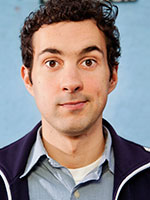Death: Feb. 24, 1998
BlueMeter: Clean
Works
Records
| 2005 | The Primitive Sounds of Henny Youngman | |
| 2001 | Henny Youngman Himself | |
| 1997 | The Best of the Worst of Henny Youngman | |
| 1990 | Henny Youngman In Person | |
| 1985 | Best of Comic Relief, Vol. 1 This album is a compilation, featuring multiple comics. |
|
| 1980 | Henny Youngman's 128 Greatest Jokes | |
| 1978 | Take My Album Please (Or Two Sets for the Price of One) |
Specials (and other video)
| 1984 | The Young at Heart Comedians Special |
Books (by and about)
| 2000 | Take My Wife, Please: Henny Youngman's Giant Book of Jokes |
Biography
Henny Youngman grew up in Brooklyn, the son of Jewish immigrants.
After dropping out of high school, Henny attended the Brooklyn Vocational School, learning the printing trade, which he would use to earn a living making business cards.
Youngman had performing aspirations however, forming a musical group called "The Syncopaters." The band performed around New York, particularly in the booming Catskill resorts during the roaring Twenties.
A 1932 performance at the Swan Lake Inn would turn Youngman to comedy. The master of ceremonies for the evening had taken ill, and Youngman volunteered to step in.
Becoming a professional comedian is hard at any time. But becoming one during the depression is especially difficult. While an aspiring comedian, Youngman was once paid 50 cents to sit in the audience and laugh at jokes told by <strong><a href="/comedians/comic/milton-berle">Milton Berle</a></strong>.
Youngman's first big break came in 1936, when he appeared on the radio variety show "The Kate Smith Show."
Youngman would play violin occasionally between jokes, connecting material without segue-ways. Leaving out any transitions meant to Henny that he was only giving the audience the funny stuff, no filler. This pacing sped up the act, almost ensuring that if an audience didn't like one gag, another would be coming seconds later that they would. The patter would wear nearly any audience down over time.
His most famous joke — "Take my wife, please." — had its origins in a misunderstanding. While backstage prior to a 1940s performances at the Kate Smith show he asked a usher to "Take my wife, please." Youngman has meant for the man to help his wife find a seat, but the line sounded like something else entirely.
Youngman's material was all impersonal one-liners, many of which were time-worn when he got a hold of them. His contemporaries looked down upon his performing style, but his reliances on these bits endeared him to club owners. Unlike a comedian who was still working out a more personal bit, Youngman was a consistent and thus reliable performer. And with the speed and frequency Youngman told jokes, he could always find an audience that found these standards new to them.
Youngman even become the joke himself, with his name evoked as the topper for any old joke used on Rowan and Martin's Laugh-In - "Oh, that Henny Youngman!" His unwavering commitment to delivering the same spiel made him a camp pleasure.
Youngman acted as his own manager for many years, with his personal number in the New York Yellow Pages. He would happily taking on any gig that met his fee and appeared anywhere from banquet halls to conventions to night clubs. Youngman was renowned for booking secondary gigs while at a venue. He'd negotiate to do a few minutes a a bat mitzvah or wedding, sometimes when they were already in progress, in exchange for anywhere to $100 - $500 cash.
In the 1970s, Youngman had a dial-a-joke phone line, where people could call in and hear the comic spit several one liners in a single minute.
His 1980 album for Rhino Records entitled "128 Greatest Jokes" had a unique "trick track" mastering. Depending on where the needle is placed, one of four routines will be played. His 1990 album, "Henny Youngman in Person" was only available via mail order.
Youngman was bat mitzvah-ed late in life, almost sixty years after the normal age.









